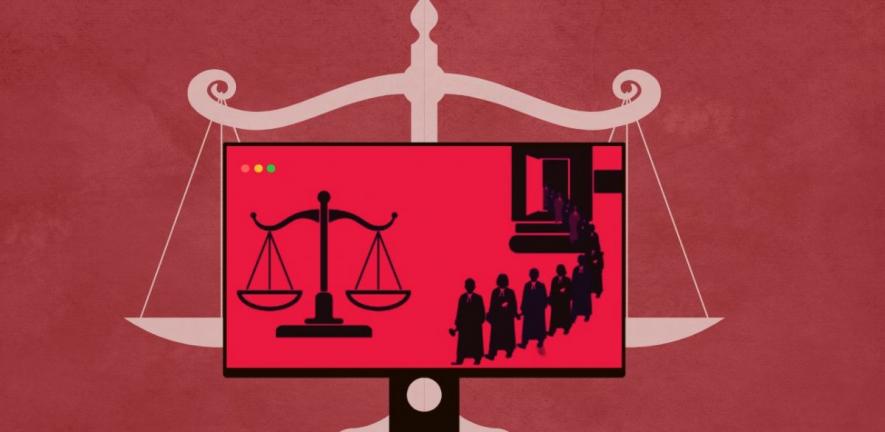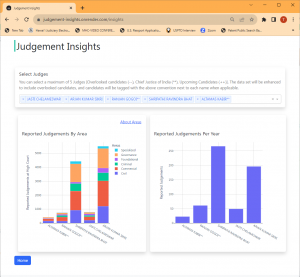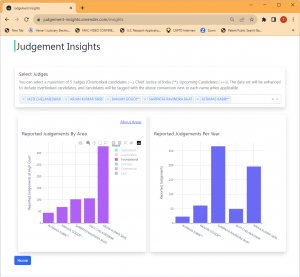Judicial Appointments: Towards a Blueprint for Information Systems in Governance

Image for representational purpose. Credit: The Leaflet
Can a certain metric system be used to collect and compare data for judicial appointments in the Supreme Court and high courts to make the collegium system more comprehensive?
Computer technologists will assert that implementing information systems for measuring judicial performance is a fairly easy task given that judicial processes are based primarily on a set of procedural rules and a written record.
However, the primary impediment in achieving that objective is the availability of relevant raw data that captures the workflows of the judiciary comprehensively.
This is a bit counterintuitive because such workflow data is already stored on computer systems that the judiciary uses.
Significantly, India does have a National Data Sharing and Accessibility Policy and the government does publish some base datasets at data.gov.in, but the type of datasets shared with the public do not cover those of substantial interest or concern to the public covering the workflows or spending of government organs.
Government organs of many other countries and organisations have recently been making efforts to provide such base datasets.
A demonstrative example of such base workflow data can be found at https://ped.uspto.gov/peds/#/, where the US Patent Office has digitised their workflow data since 1900 (i.e., covering more than a hundred years) and permits any web user to download the entire data or selected pieces of data.
Any application developer can then develop informative user interfaces (e.g., https://www.patentbots.com/stats/) based on the data sets made available on the US Patent Office website.
In this backdrop, this paper describes a web-based application (developed by the authors) with a single material metric— as relevant to judicial appointments in India— and notes reasonable extensions that can be readily implemented which can bring objectivity to the appointment of Supreme Court judges
The solution can also serve as a blueprint for information systems in governance.
It is hoped that this exercise will impress upon the judiciary the need to redesign computer systems the government uses, so that the data generated by computer systems is more useful to the public as well as the authorities.
Significance of data-driven assistance
In an era in which the flow of information is ceaseless, governments around the world are embracing data-driven governance as a transformative approach to decision-making and policy formulation.
Data-driven governance refers to the practice of utilising data to guide policy choices, enhancing service delivery and promoting overall efficiency in the functioning of the system.
This approach holds immense importance in today’s rapidly evolving socio-economic landscape, as it empowers governments to make more informed and evidence-based decisions, fosters transparency, and ultimately leads to improved public services and citizen well-being.
Web-based app
A publicly available web-based app has been developed which enables users to compare the number of published judgements delivered in high courts by the judges appointed to the Supreme Court, high court judges overlooked for promotion and prospective judges in line for elevation.
Graphs 1 and 2 offer the results of such a comparison.

Graph 1: Count of reported judgments at the high courts
Graph 2: Number of reported judgments per year
It can be seen that the fifth Supreme Court judge has the highest number of published judgments as a high court judge (see Graph 1), while the third Supreme Court judge has the highest number of published judgments per year (see Graph 2).
This data on published judgments is clearly one of the most important metrics (for the selection of judges) as it measures the number of cases that were resolved by a particular judge and also shows the respective areas of law that were dealt with by them during adjudication.
If we want to compare just foundational or constitutional cases of the five judges, the app allows us to do so by de-selecting the other areas.

Graph 3: Foundational cases at a high court
To illustrate, Graph 3 shows that the fourth and fifth judges have handled more constitutional law cases (which arguably require more time and thought), possibly pointing to why the fourth judges’ overall number of judgments is low (see Graph 1).
User interface attributes of the app
Advancements in digital technology and the availability of a vibrant technology ecosystem and people in India have made it possible to create better user interfaces that meaningfully summarise vast amounts of raw data (whether related to workflows or otherwise) that is continually generated every day.
If such base data (sets) are enabled to be used in apps such as the one proposed, it can have a significantly positive impact on information systems related to governance.
If the judiciary can extend its computer systems so that their workflow data is easily accessible as datasets, it can vastly improve the efficiency and transparency of their processes as a whole, including appointments.
Once such datasets are available, they will facilitate development of apps (by government or public) that properly measure and inform the efficacy of government functions.
The critical attributes of the user interface of such apps are comparison of similar things as a basis for information, comparison at the right level of abstraction, and filtering out data that tend to clutter understanding.
Apps with well designed user interfaces will allow inherent checks and balances and easy comparisons.
Additional data needed
A higher number of judgments spread over all the six verticals, as shown in Graph 1, possibly means that the judge has demonstrated experience to preside over diverse areas of laws that are very likely to come up at the Supreme Court.
However, given the manifold difference between the highest and lowest number of judgments given in the above graphs, it is clear that additional metrics should be considered to fully showcase the judicial performance of each Supreme Court judge when they were a high court judge.
Some of these metrics are briefly discussed as follows.
More quantitative output measures
The number of published judgments, the number of Bench a judge participated in (without authoring judgments), caseload of the judge after considering the Orders passed by the judge, their record on appeals and the dissents etc., should be noted down in a dossier, so that a comparison can be made with the performance of other judges at a similar level.
The user interface app allows us to do so.
Time spent per hearing
At present, the time spent by a judge on each case is not recorded properly. This is crucial data and should be noted properly.
High courts have a facility which displays the number of cases on the cause list that are currently being heard by them.
This facility displays the status of cases, indirectly indicating the approximate time spent by a judge on each case.
Qualitative measures
Techniques like natural language processing should be employed to examine all published cases by each judge and meaningful metrics on quality of judgments wherein relevant cases have been cited and there is proper analysis of facts should be mentioned in the processing technique.
Case management data
For each judge, it will be interesting to measure how well the court’s time and processes have been used in adjudicating cases.
For procedural integrity, ‘judgment reserved’ practice, ‘partially heard’ practice, and whether parties file relevant documents in a timely manner, etc., can also be measured.
Future and impact
When referring a high court judge for elevation to the Supreme Court, the explanatory notes provided by the appointing authority should successfully show that the judge was referred after comparing reasonable measured parameters with other judges.
Similar metrics should be developed for advocates elevated directly to the Supreme Court Bench.
As the judiciary in India uses software developed from Central agencies, it presents an immediate opportunity to make a pertinent measured dossier, an integral part of appointments at all levels— from munsif courts all the way to the Supreme Court.
Even if the government does not directly provide the aforementioned user interfaces, there is still no doubt that the government is required to design their computer systems to make pertinent base data available to interested parties as corresponding data sets.
It should be noted that many non-governmental organisations rely on ‘scraping’ and significant pre-processing of data before they analyse it.
Web scraping is a process of extracting data from a website into a structured format using computer programmes like Python.
Scraping should be required only as an exception, and a more respectful approach is for the authorities to provide appropriate data sets of public interest proactively. Such data sets should include the aforementioned additional data sets as well.
Only when the Supreme Court embraces the suggestions herein, which apply to it, will the court have the moral authority to enforce similar rules in other spheres that scream for information systems that can curtail arbitrariness and corruption in spending and regulation.
(Vaishnavi Pratap and Subhash Bhushan also co-authored this piece. Vaishnavi is an advocate specialising in intellectual property law. She is passionate about constitutional law and good governance. She enjoys reading, travelling and music.
Subhash is a seasoned entrepreneur with over 20 years of experience and specialises in web application development. A fervent advocate for cutting-edge technologies, he keeps a keen eye on advancements in AI and data science. When not immersed in work, Subhash indulges in sailing and rigorous technical research.
Seenu Banda is a passionate technologist and innovator who is dedicated to solving problems using technology. When he is not busy working on the latest tech projects, Seenu likes to spend time with his friends and family, either watching or playing sports.
Naren Thappeta is an advocate with a strong computer science background. He is passionate about ensuring data is appropriately used in all areas of governance. He plays badminton mostly every day, enjoys travel and food.
The views expressed are personal.)
Get the latest reports & analysis with people's perspective on Protests, movements & deep analytical videos, discussions of the current affairs in your Telegram app. Subscribe to NewsClick's Telegram channel & get Real-Time updates on stories, as they get published on our website.
























